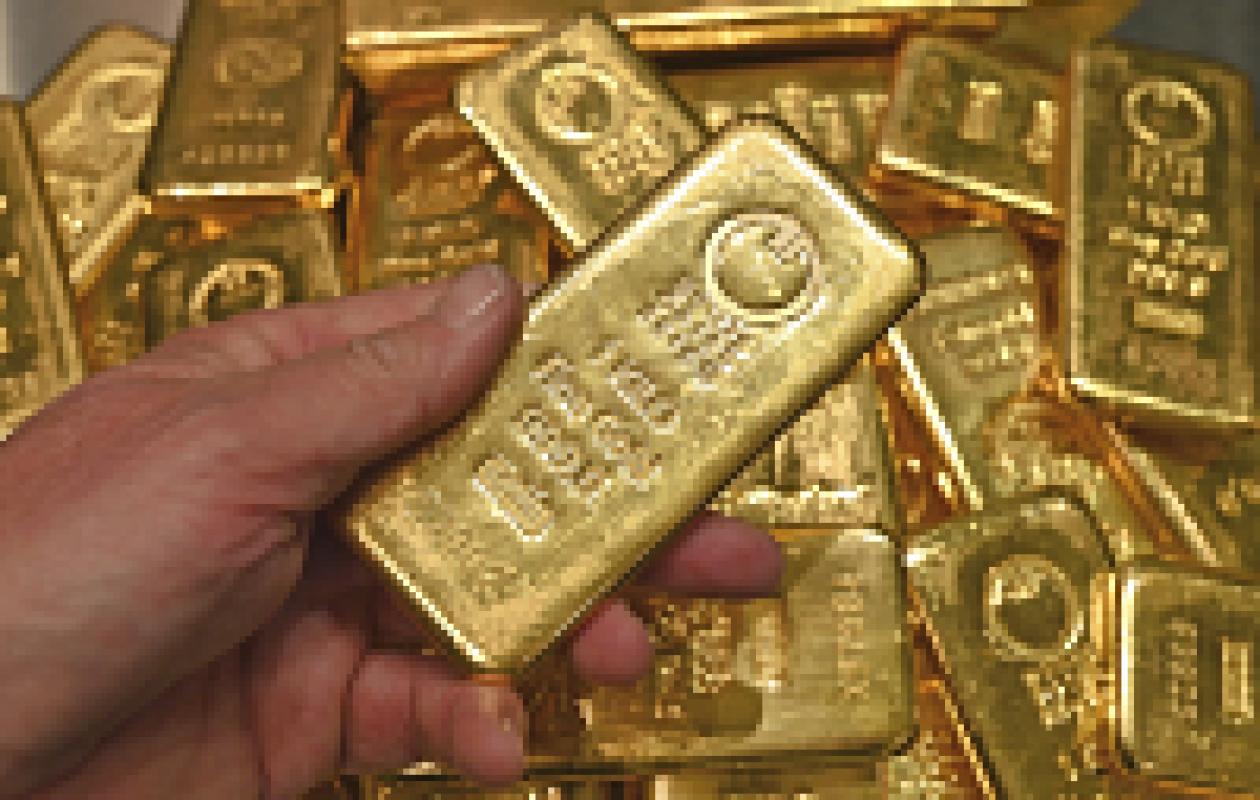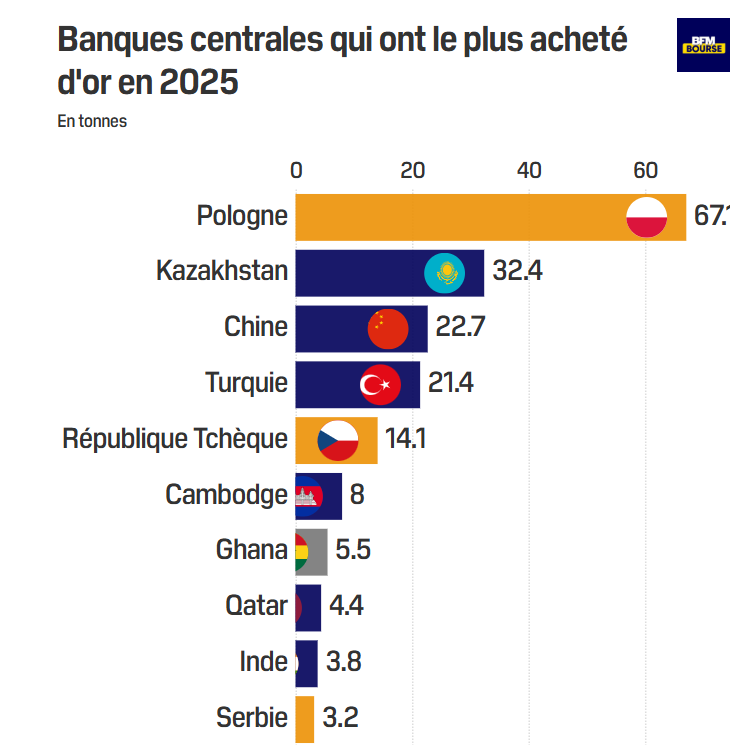
Or : Alors que l'or a franchi cette semaine la barre des 4.000 dollars l'once, quels sont les pays qui en détiennent le plus en 2025?
(BFM Bourse) - Gold prices crossed the symbolic threshold of $4,000 per ounce this week. Geopolitical and economic tensions fueled demand for the yellow metal, as did significant central bank purchases. Among these buyers, which countries increased their gold reserves the most by 2025? And which central banks hold the most?
In less than two years, gold has experienced a sparkling rise, and its price this week crossed the symbolic threshold of $4,000 an ounce for the first time.
Currently, the price of the precious metal is up nearly 50% year-on-year, fueled by rising economic and geopolitical tensions, which have themselves been amplified by the US administration's tariff measures. These uncertainties have reinforced gold's role as a traditional safe haven, fueling demand.
"Gold has long reflected global economic and political tensions, with its price typically rising in times of heightened uncertainty. In the aftermath of the global financial crisis, gold surpassed $1,000. During the Covid-19 pandemic, it climbed to $2,000. More recently, amid Donald Trump's tariff announcements, it surpassed the $3,000 mark," ING economists explain.
Appetite for the yellow metal was also fueled by purchases linked to gold-linked exchange-traded funds (ETFs). "Last week, gold-backed exchange-traded funds rose again, bringing total holdings in gold ETFs to their highest level since September 2022. There is still room for further additions, given that the current total remains below the peak reached in 2020. Further inflows could push gold even higher," observe ING economists.
Demand was also driven by significant purchases by central banks in emerging countries seeking to diversify their reserves. "This trend was initially driven by countries' concerns about sanctions on their foreign assets following the decisions of the United States and Europe to freeze Russian assets. However, this trend has evolved into a broader strategy of diversifying dollar reserves and holdings," UBS noted in February.
So, which central banks have been the most active in gold purchases this year? The Bestbrokers team compiled data from the World Gold Council (WGC) available in September, which allowed them to identify the countries (or more precisely, the central banks of these countries) that have increased their gold reserves the most in 2025, as well as the states that hold the most.
The Ukrainian conflict at Poland's doorstep
Central banks played a key role in the rise in gold prices, as several countries continued to increase their gold reserves this year. Poland was again the most active country in this regard, increasing its reserve by 67.1 tonnes of gold since the beginning of 2025, after increasing it by 89.54 tonnes of gold, an increase of nearly 25%, in 2024.
Bestbrokers points out that geopolitical tensions, particularly Russia's invasion of Ukraine, explain why the country's central bank has had to play the ant. The idea is to send a signal of confidence in the Polish economy while a major conflict is taking place on the country's doorstep.
"If it (a national bank) has large reserves, a large part of which is in gold, it means that the country is reliable... and that it is a country in which trade and investment are possible," Polish English-language television TVP World quoted him as saying in 2024.
Poland could have acquired more gold, but high prices have somewhat curbed the amounts purchased. According to data compiled by Bestbrokers, the "Land of Fields" (the country's nickname) currently holds more than 513.33 tons of gold (approximately 21% of its total reserves), ranking it twelfth in the world for its gold holdings.
In September, the country officially raised its target for holding gold in its international reserves to 30% of the total, after reaching its previous target of 20%, the World Gold Council said.
After Poland, Kazakhstan is the second country to have increased its gold reserves the most, reaching 32.4 tonnes in 2025. The Central Asian country is reactivating its policy of purchasing this precious metal, after having sold 10.2 tonnes in 2024.
China has not slowed its insatiable desire for gold, adding 22.7 tonnes to its already substantial reserves by 2025. These purchases bring China's official reserves to more than 2,300 tonnes, cementing its position as the world's sixth-largest gold holder.
"The People's Bank of China extended its gold buying spree in September for the eleventh consecutive month, despite record prices," ING noted.
Turkey continued to increase its reserves in 2025 by purchasing 19.5 tonnes of gold, after having already acquired 77.4 tonnes last year. The Czech Republic, Cambodia, Qatar, Ghana, India, and Serbia are also among the top ten gold buyers.
Looking ahead, ING believes central banks will continue to add gold to their reserves, given the still uncertain economic environment and the desire to diversify away from the US dollar.
Gold a "cornerstone"
The Bestbrokers study also looked at Kyrgyzstan, which purchased 2.2 tonnes of gold in 2025, a much smaller amount than the 16.6 tonnes the country acquired in 2024.
"This slowdown can be explained both by high international prices and a more cautious approach to diversifying reserves. Despite this, gold remains the cornerstone of its portfolio: the 40.3 tonnes held by the country now represent 64.4% of total reserves," the authors of the study explain.
On the other hand, some countries have taken the opposite approach by divesting some of their gold holdings. Some central banks have profited from the rise in the price of the precious metal, which rose from $2,629.95 on September 30, 2024, to $3,825.30 on September 30, 2025, an increase of $1,195.35. They may have been tempted to turn the gold they held into cash and thus take their profits.
Uzbekistan, for example, sold more gold than it bought, resulting in a net decrease in official gold reserves of 16.8 tonnes. "These transactions make Uzbekistan the largest net seller of gold this year, reflecting a strategic shift in how it manages its reserves," the study said. 
"America First"
The United States remains the country with the largest gold reserves in the world, with 8,133.46 tons. Germany and Italy follow with 3,350.25 tons and 2,451.84 tons. France is not far behind, with gold reserves of 2,437 tons, followed by Russia with 2,329.63 tons. China has 2,302 tons, and Switzerland has 1,039 tons.
Bestbrokers also points out that not all countries report their gold holdings to the International Monetary Fund. Some countries have very few gold reserves, or none at all.
For one country in particular, this is even an anomaly. Canada is one of the world's largest gold producers, but it has no gold reserves. The Bank of Canada does not consider gold as liquid an asset as, say, U.S. Treasury securities.
"Our international monetary system is now sufficiently robust that holding an instrument of stability as ancient and outdated as gold really no longer makes any sense," former Bank of Canada Governor David Dodge told Kitco News in 2022.
Norway is another country with virtually no gold reserves. In 2004, Norges Bank announced that it would sell all of its gold reserves. A total of seven gold bars and a few gold coins were kept for exhibition purposes.
"These cases stand in stark contrast to most other advanced economies, where gold continues to represent a significant portion of central bank reserves. They highlight that not all major economies consider the precious metal essential to their reserve strategy, even countries with a large mining industry like Canada or historical reserves like Norway," Bestbrokers reports.
A "trend that has a bright future ahead of it"
For ING, this bullish trend in gold "still has a bright future ahead of it." The Dutch bank cites continued central bank purchases and Donald Trump's trade war as catalysts. The Dutch bank also expects increased ETF holdings and heightened expectations of further rate cuts by the US Federal Reserve.
This prompted the company to raise its gold forecast. ING now expects an average price of $4,000 per ounce in the fourth quarter, which would bring the annual average to $3,402 per ounce, before reaching an average price of $4,150 per ounce in 2026.
Commentaires (5)
Nous on a des gisements mais tout quitte le pays directement de kedougou
Make money while staying at home and working online. I just received $23,783 for my work last month, and I was doing this part-time. This year, I plan to earn even more, and I believe you can also make extra cash from this job. To join right now, follow the details on this website.
Open This... Www.Work99.site
Je le dis depuis toujours. Il faut que le Sénégal ouvre ses propres mines d'or.
quand jetais en arabie saoudite une amie mavait dit de ne pas acheter de l'or car ca ne vaut pas la peine , l'OR est cher, et je lui avais demande mais Arabie saoudite a de l'or , elle ma dit, non pas dor , la chine a fait que l'or est trop cher.. Kou amm or en ce moment boumouko diaye.. nakh or dafa cher, mais le prix de vente sera bas.. les marchands ne vont jamais te donner le prix d'achat.. ils vont casser le prix..
Des pays qui n'ont des gisements et pourtant ont plus de réserve
Nous on a des gisements mais tout quitte le pays directement de kedougou
Participer à la Discussion